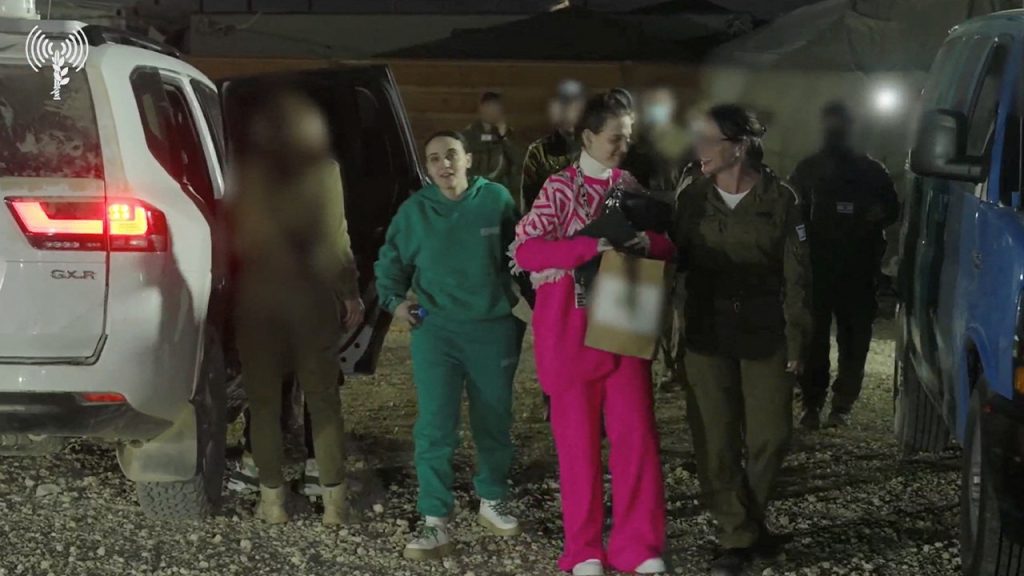The initial phase of the cease-fire agreement between Israel and Hamas brought a bittersweet reunion for three Israeli hostages and their families. Emily Damari, Romi Goren, and Doron Steinbrecher, abducted during the devastating October 7th attacks, returned to Israel after over 471 days in captivity. Their release marked a significant step in the complex negotiations, yet it was tinged with the symbolic presence of Hamas’s influence. Each woman carried a paper “gift bag” bearing the terror organization’s logo, containing items such as a map of Gaza, photographs from their captivity, and certificates documenting their release. These items, later confiscated by the Israel Security Agency, served as a stark reminder of the ordeal they endured and the political backdrop of their freedom. The families expressed immense relief and gratitude for their loved ones’ return, acknowledging the support they received from various sources, including the Israeli public, President Trump, and in Damari’s case, the British government.
The women’s return was met with mixed emotions. While their families rejoiced at their safe return, the circumstances surrounding their release were a stark reminder of the ongoing conflict and the power Hamas wields. The “gift bags” served as a symbolic gesture, highlighting the organization’s role in their captivity and subsequent release. The items within, though seemingly innocuous, carried the weight of the women’s experiences, underscoring the complex and often unsettling dynamics at play. The families’ expressions of gratitude were tempered by the knowledge that other hostages remained in captivity, their fates hanging in the balance of ongoing negotiations.
The hostage release was part of a broader cease-fire deal that included the phased release of 33 Israeli hostages in exchange for the release of nearly 2,000 Palestinian prisoners and detainees. This exchange, while celebrated by some Palestinians, particularly in the West Bank where crowds cheered and Hamas flags were reportedly waved, further underscores the deeply ingrained political complexities of the region. The exchange of prisoners for hostages highlights the difficult choices and compromises necessary to navigate the volatile landscape and secure the release of those held captive. This act, while bringing relief to the families of the hostages, also fueled existing tensions and highlighted the divergent perspectives on the conflict.
The release of the first three hostages marked a tangible step in the implementation of the cease-fire agreement, offering a glimmer of hope amidst the ongoing conflict. The agreement, brokered through intense negotiations, aimed to de-escalate tensions and pave the way for a more sustainable peace. The phased release of hostages was designed to build trust and ensure compliance from both sides. However, the celebratory reactions from some within the Palestinian community, including the display of Hamas flags, served as a reminder of the deep divisions and the challenges that remain in achieving lasting peace.
Concurrent with the hostage release, a significant development unfolded within the Israeli Defense Forces (IDF). Lt. Gen. Herzi Halevi, Chief of the General Staff, announced his resignation, taking responsibility for what he termed the IDF’s failure on October 7th, the day of the Hamas attacks. Halevi’s decision to step down reflects the gravity of the security breaches that led to the hostage crisis and the subsequent conflict. His resignation also highlights the importance of accountability within the military and the acknowledgment of shortcomings in the face of such a significant security failure.
Halevi’s announcement underscored the profound impact of the October 7th attacks, extending beyond the immediate casualties and hostage situation. His resignation signals a period of introspection and reform within the IDF, as they grapple with the implications of the security breaches and seek to enhance their preparedness for future challenges. His decision, while accepted by Defense Minister Israel Katz and Prime Minister Netanyahu, leaves a significant void in the IDF leadership at a crucial juncture in the ongoing conflict. The search for a successor will undoubtedly be a critical process, as the IDF navigates the complexities of the cease-fire agreement and addresses the broader security concerns facing Israel.

